Poon Hill Trek is a short and classic one at the heart of Annapurna Sanctuary. But it offers magnificent mountain views along with a peek into Gurung culture.
The brief and easy trekking to Poon Hill is an excellent option for people who have a short time but desire to have an exclusive experience of the Himalayas. This trek is ideal for novice trekkers, especially for those with no prior experience in the foothills of the Himalayas.
Unlike most of the short treks, Poon Hill rewards you with the picturesque mountain vistas including Dhaulagiri, Nilgiri, Annapurna South, Annapurna I, Hiunchuli, Machhapuchhre, Lamjung Himal as well as Manaslu.
Poon Hill is considered one of the best viewpoints in the entire Annapurna region. The sunrise and sunset over the snow-capped massifs from atop Poon Hill is one of the best sights in the whole trek.
The tiny village of Ghandruk is another highlight of Poon Hill Trek. Famous for the warm hospitality of the locals and cultural insight of the town, Ghandruk is the second largest Gurung village in Nepal.
Table of Content
Highlights of Poon Hill Trek
- Visit the marvelous city of Pokhara.
- Relish the amphitheater-like view of the picturesque mountains, including Annapurna, Machhapuchhre, and Dhaulagiri.
- Explore the traditional Gurung village at Ghandruk and indulge in their rich culture.
- Traverse through the Himalayan trail decorated with crimson rhododendron.
- An easy and comfortable trek in the Annapurna Sanctuary.
Poon Hill Trek Facts
| Trip Duration | 5 Days |
| Maximum Altitude | 3,210m at Poon Hill |
| Trip Difficulty | Easy |
| Accommodation | Teahouse/Lodge |
| Walking Duration | 5-6 hours per day |
| Best Time to Trek | Autumn and Spring |
| Group Size | Minimum 1 Person |
Getting There and Away
Start of the Trek:
The most popular option among some alternatives to starting Poon Hill Trek is to drive from Pokhara to Nayapul. The condition of the road to Nayapul is decent, compared to other outskirts of Nepal. The entire drive covers a total distance of 45.5 kilometers and takes around two hours.
As per your preference, you can either ride a local bus or a private car, taxi, or van to reach Nayapul. The local transportations are scheduled to leave every hour from Baglung Bus Park in Pokhara, and a public bus will charge you as little as US$ 2 per person.
If you choose to hire a taxi or van, it’ll cost you about US$ 35, but the drive will be relatively faster and comfortable.
End of the Trek:
Most of the trekkers conclude this trek with a drive from Ghandruk to Pokhara. You can catch a local bus or a local van from the Ghandruk Bus Stop. The cost of a local bus from Ghandruk to Pokhara is US$ 5 per person.
You can also take a local van from Ghandruk to Pokhara. The local van costs you around US$ 8 to 10 each person as per the number of passengers.
Alternative Route for Poon Hill Trek
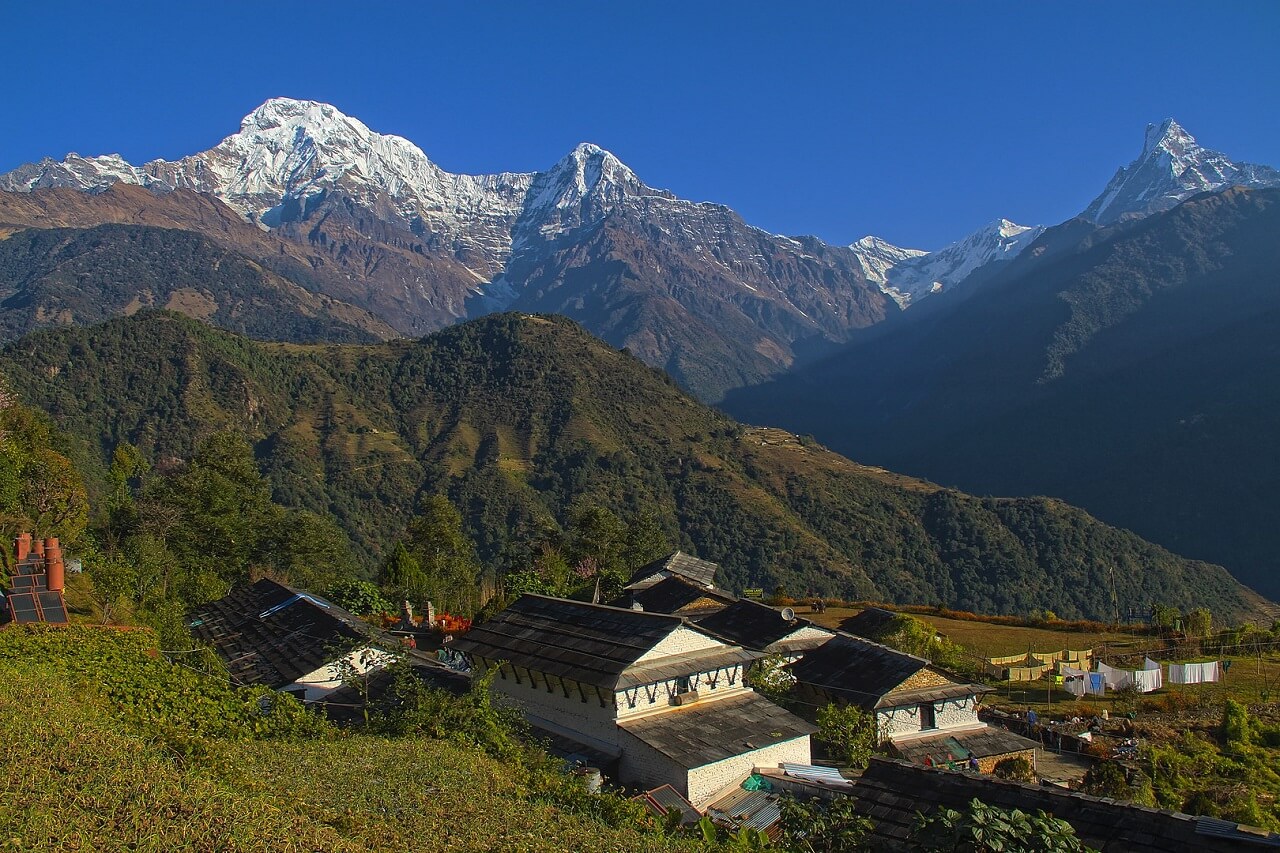
Ghandruk to Nayapul – 40km
This alternative option to Poon Hill follows the reversed route to that of the standard itinerary. On this route, you begin the adventure with a 3-hour drive from Pokhara to Ghandruk. You’ll trek through famous settlements like Tadapani and Ghorepani towards Poon Hill.
Furthermore, you descend via Ulleri towards Nayapul to end the trek. This route covers a total distance of 40km.
Nayapul to Kimche – 44km
If you take this route, you’ll follow the entire standard itinerary and walk to Kimche from Ghandruk instead of driving. This additional 4km is the only variation on this route option.
The trek begins with a drive to Nayapul then passes through the village of Ulleri and Ghorepani to arrive at Poon Hill. Then, the trail descends to Ghandruk via Tadapani and further leads to Kimche to end the trek.
Poon Hill Trek Outline Itinerary
| Day | Itinerary | Altitude from (Meter) | Altitude to (Meter) | Trekking Duration |
|---|---|---|---|---|
| 1 | Drive from Pokhara to Nayapul (1,070m) and Trek to Tikhedhunga | 900 | 1,570 | 6-7 hrs |
| 2 | Trek from Tikhedhunga to Ghorepani | 1,570 | 2,750 | 5-6 hrs |
| 3 | Hike to Poon Hill (3,210m) and Trek to Tadapani | 2,750 | 2,500 | 4-5 hrs |
| 4 | Trek from Tadapani to Ghandruk | 2,500 | 1,940 | 3-4 hrs |
| 5 | Drive from Ghandruk to Pokhara via Nayapul (1,070m) | 1,940 | 900 | 5-6 hrs |
Poon Hill Trek Detailed Itinerary
Day 1: Drive from Pokhara to Nayapul (1,070m) and Trek to Tikhedhunga
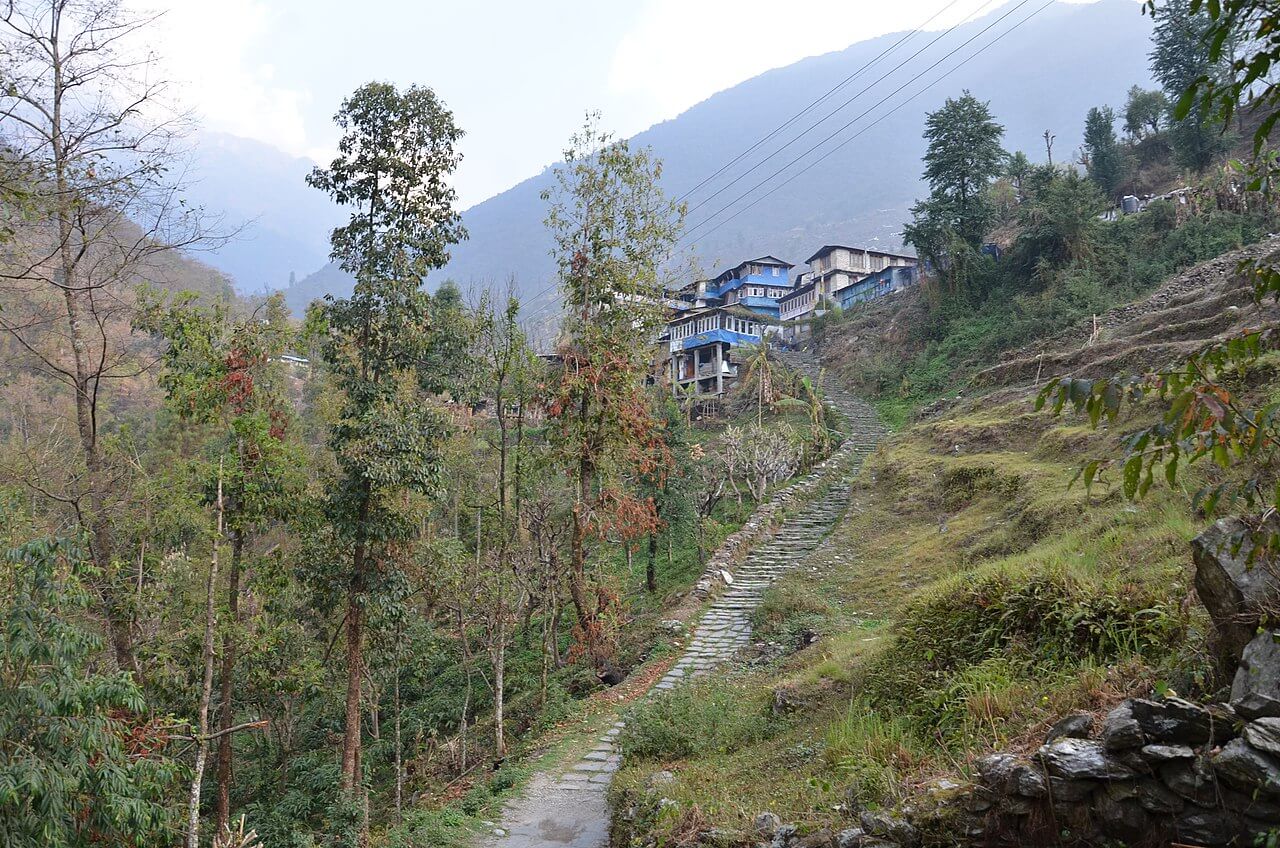
Begin the adventure with a 2-hour drive from the city of Pokhara to Nayapul. However, the bus ride may take slightly more time than expected. You can catch local buses every hour from Baglung Bus Park or can also take a local van to Nayapul.
The condition of the road is rough and twisted. Upon reaching Nayapul, you’ll start trekking through the small settlement alongside Modi Khola to Birethanti. Further, you climb through the rural villages to Tikhedhunga.
Day 2: Trek from Tikhedhunga to Ghorepani
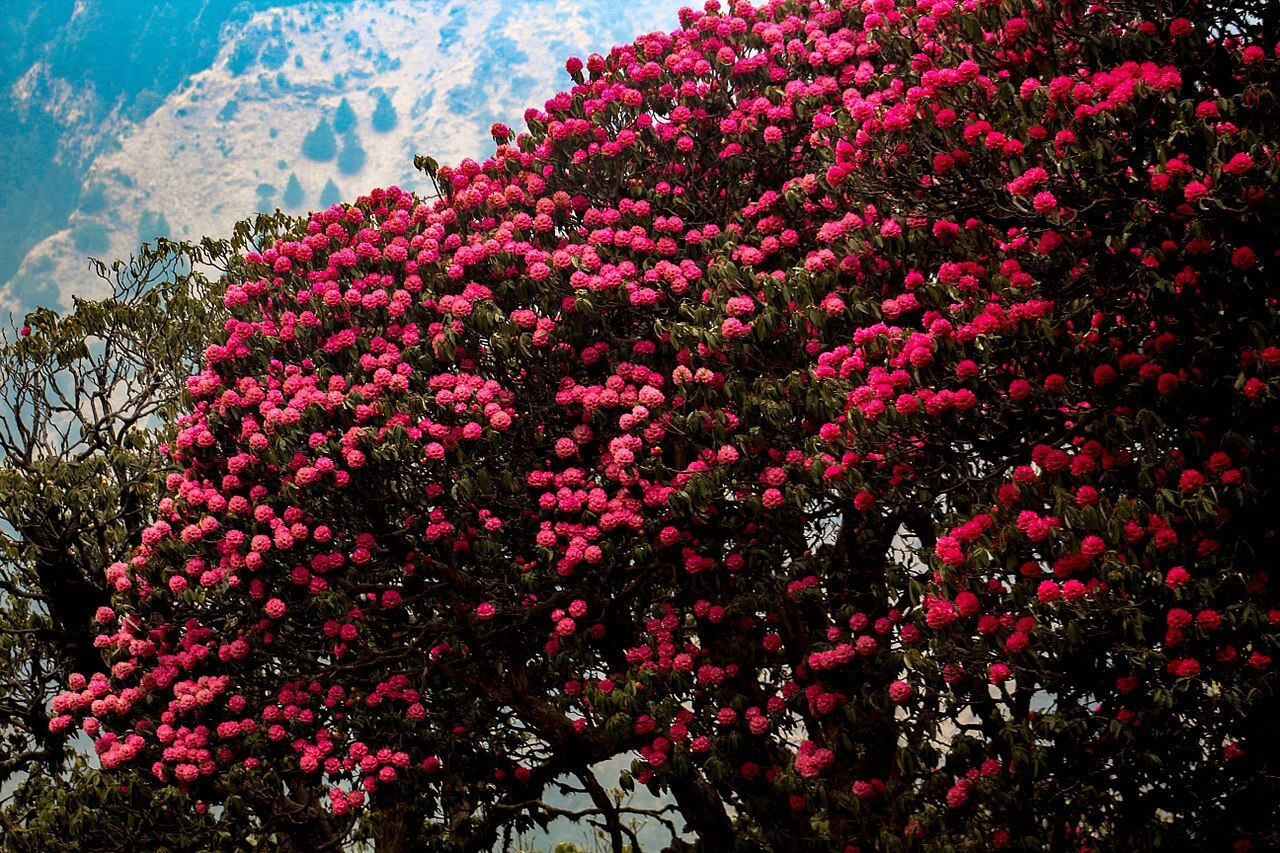
The trail is short but strenuous so start your day early in the morning. The day begins with a steep uphill from Tikhedhunga towards Ulleri. The trail leads to the dense forest passing small waterfalls, rivers, and villages.
After passing Ulleri, the trail is mostly gradual through the shades of rhododendron, pine, and oak trees. At Ghorepani, there’s a small checkpoint where they inspect your TIMS card and ACAP Permit. The temperature is not extremely cold in Ghorepani, but it is more windy and chilly compared to Tikhedhunga.
Day 3: Hike to Poon Hill (3,210m) and Trek to Tadapani
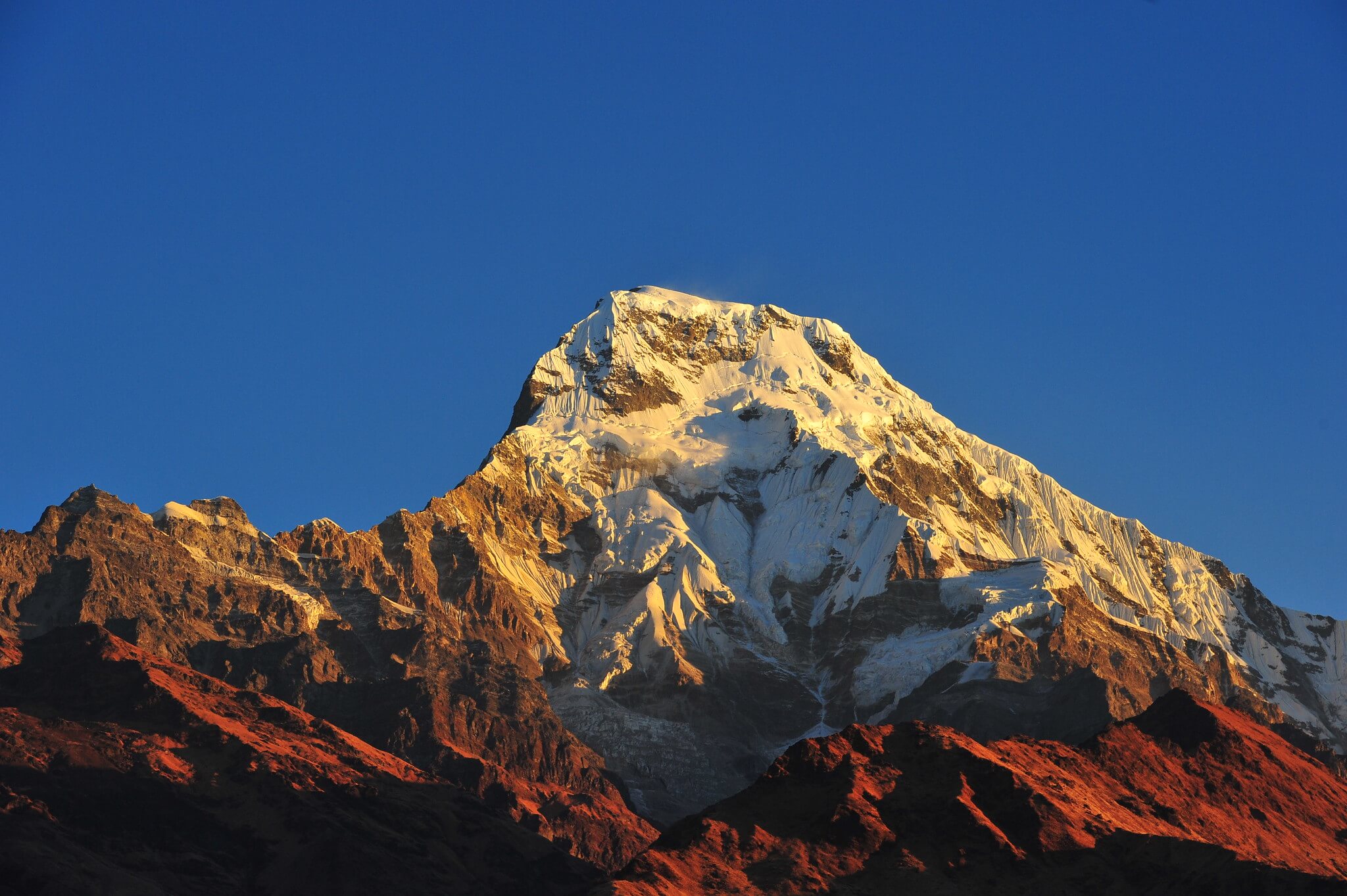
Today marks the highlight of the trek. It takes approximately 45 minutes to 1 hour to reach Poon Hill from Ghorepani. Poon Hill is a popular vantage point that offers incredible sunrise views along with a 360-degree panorama of the mountain ranges.
You’ll get to relish the beautiful spectacles of Annapurna, Machhapuchhre, Hiunchuli, Dhaulagiri, Manaslu, and Ganesh Himal. The trail climbs to Deurali with the magnificent sight of Annapurna and Dhaulagiri in the backdrop. After Deurali, the route goes steeply downhill through the dense forest until Tadapani.
Day 4: Trek from Tadapani to Ghandruk
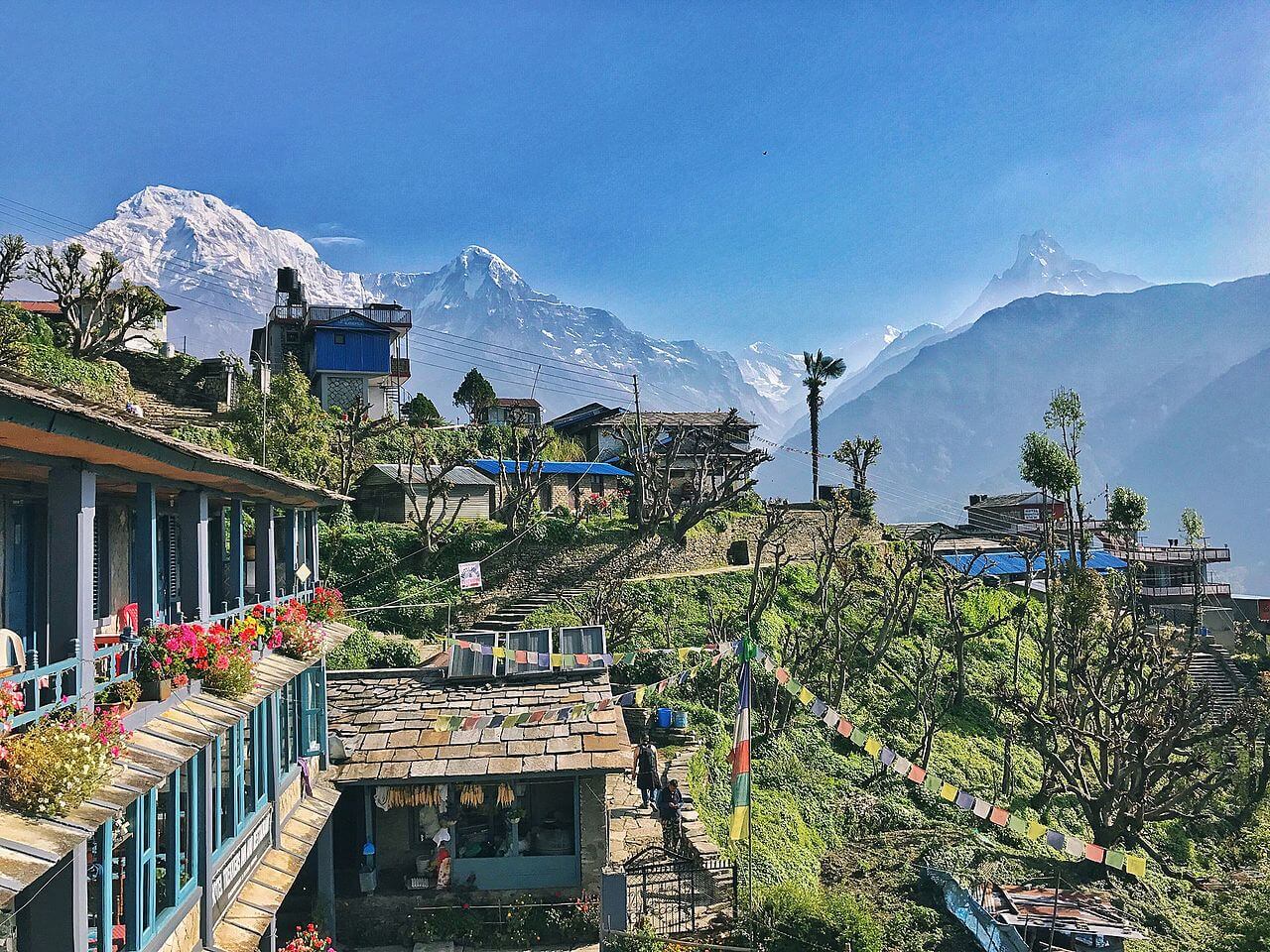
On this day, the route is mostly downhill through the shades of rhododendron forests to Ghandruk. Keep your eyes around the jungle as you may spot varieties of birds and animals along the trail.
Ghandruk is the second-largest Gurung settlement in Nepal. This village offers traditional insights and cultural experiences along with an incredible glimpse of the Himalayas.
Day 5: Drive from Ghandruk to Pokhara via Nayapul (1,070m)
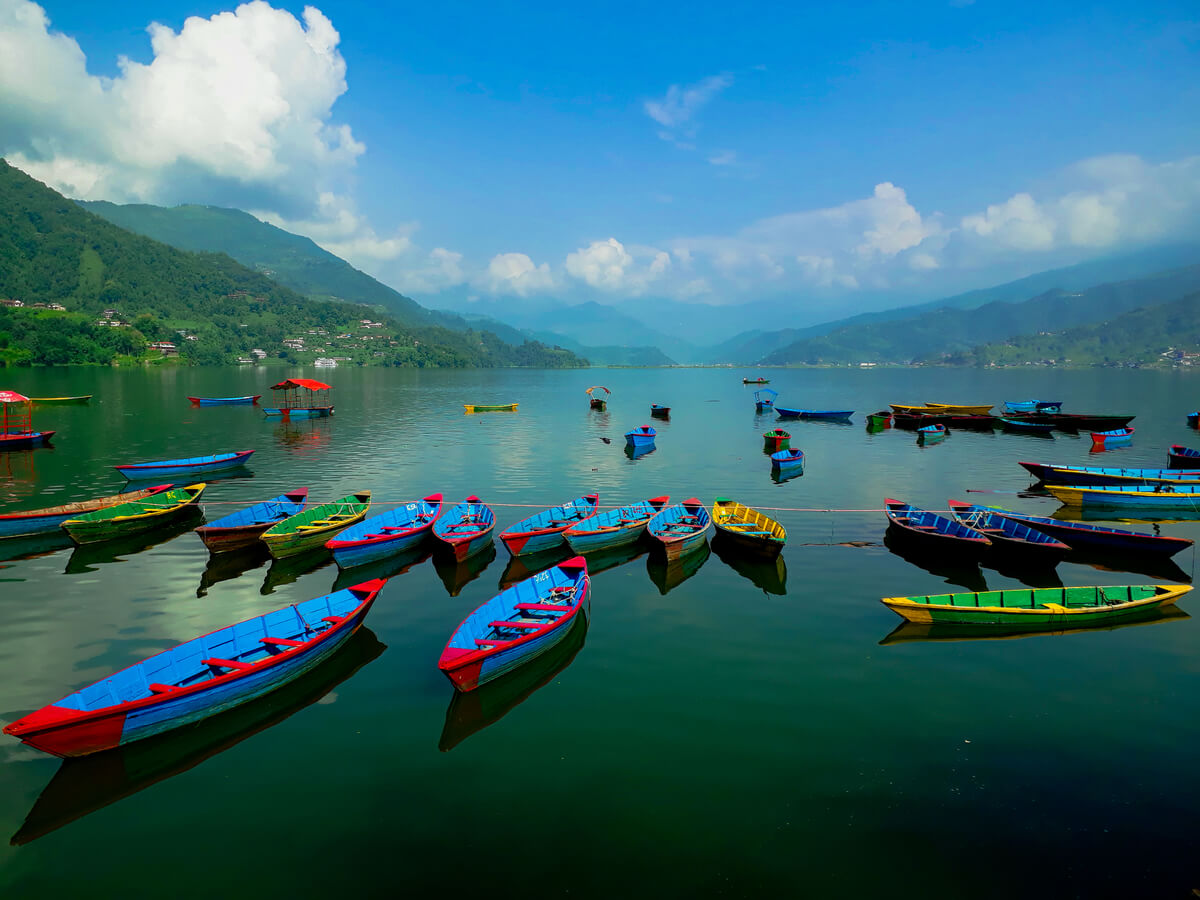
You can take a local bus or a van from Ghandruk to Pokhara. You’ll reach Pokhara in about two and a half hours if you take the local bus. A van will be a more comfortable and faster option, but they cost two or three times more money than the bus.
Poon Hill and Annapurna Extension
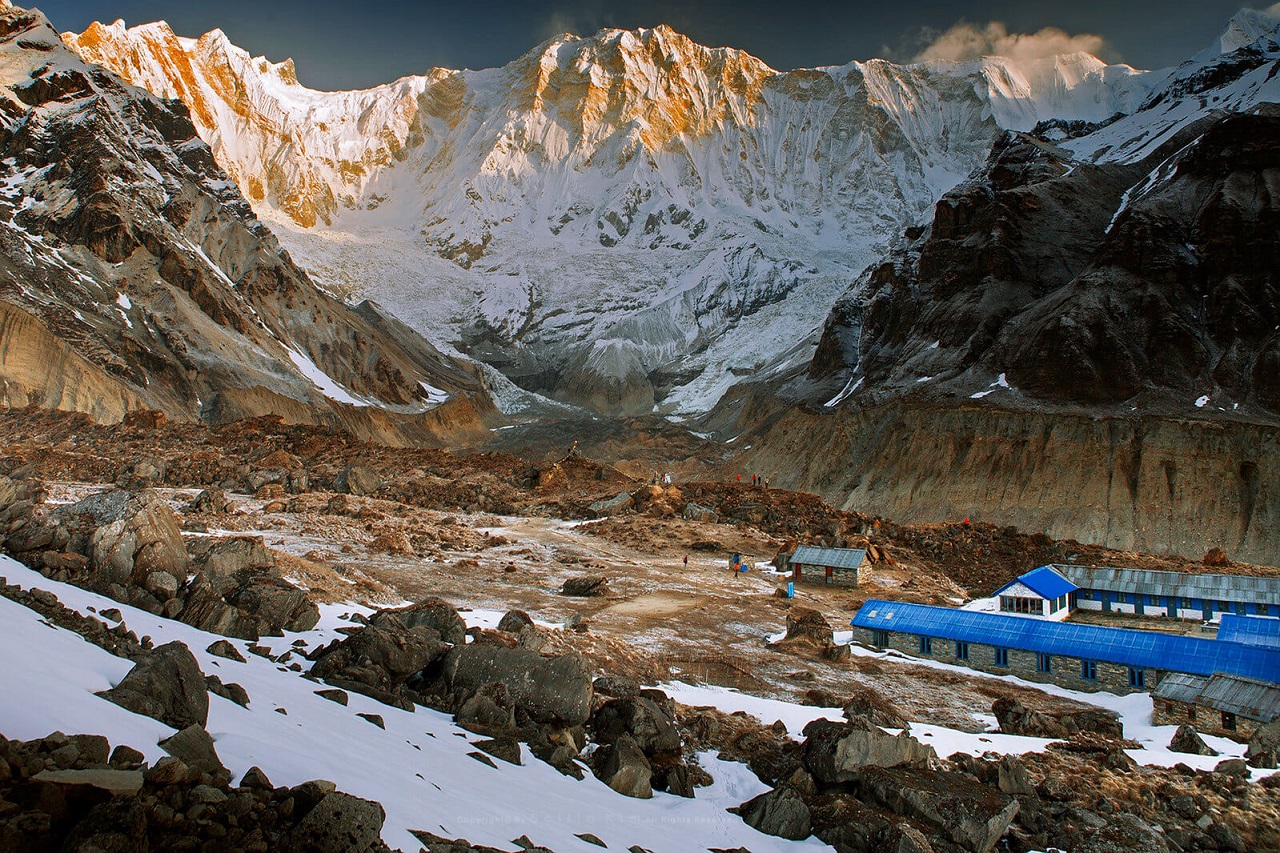
If you have enough time, you can extend this trek to the famous Annapurna Base Camp. This trek provides an opportunity to walk to the foothills of the Annapurna Massif.
Beginning the trek with a drive from Pokhara to Nayapul, you walk through several Gurung settlements to reach Poon Hill and then to Tadapani. After Tadapani, the route diverges to Chomrong connecting the Poon Hill Trek with the classic Annapurna Base Camp Trek.
It takes about EIGHT days to complete this extended itinerary stretching from 900 meters at Pokhara to 4,130 meters at Annapurna Base Camp (ABC).
Highlights of the Trek:
- Explore the beautiful valley of Pokhara.
- Relish the incredible view of snow-capped mountains including Annapurna, Machhapuchhre, and Dhaulagiri.
- Explore the second largest Gurung village at Ghandruk.
- Enjoy the majestic sunrise from Poon Hill.
| Day | Itinerary | Altitude from (Meter) | Altitude to (Meter) | Trekking Duration |
|---|---|---|---|---|
| 1 | Drive from Pokhara to Nayapul (1,070m) and Trek to Tikhedhunga | 900 | 1,570 | 6-7 hrs |
| 2 | Trek from Tikhedhunga to Ghorepani | 1,570 | 2,750 | 5-6 hrs |
| 3 | Hike to Poon Hill (3,210m) and Trek to Tadapani | 2,750 | 2,500 | 4-5 hrs |
| 4 | Trek from Tadapani to Chomrong | 2,500 | 2,170 | 5-6 hrs |
| 5 | Trek from Chomrong to Himalaya | 2,170 | 2,850 | 6-7 hrs |
| 6 | Trek from Himalaya to Annapurna Base Camp | 2,850 | 4,130 | 6-7 hrs |
| 7 | Trek from Annapurna Base Camp to Sinuwa | 4,130 | 2,360 | 6-7 hrs |
| 8 | Trek from Sinuwa to Landruk (1,565m) and Drive to Pokhara | 2,360 | 900 | 10 hrs |
Best Time to Trek Poon Hill
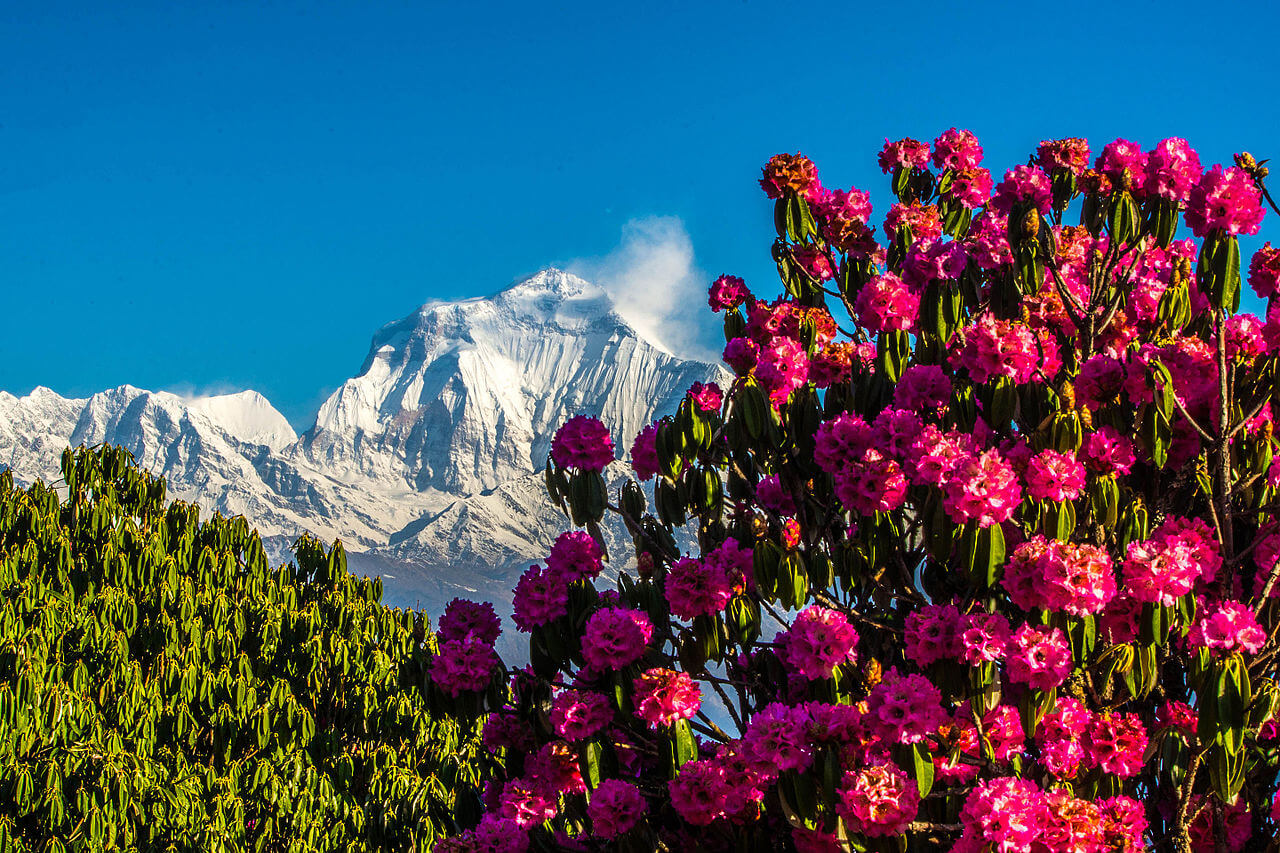
It is possible to trek to Poon Hill throughout the year. However, the weather and the view may not be clearer throughout the year. Autumn (September to November) and Spring (March to May) are the two best seasons to trek in this region.
The Autumn season is the most preferred time of the year to go to Poon Hill. The weather at this period stays moderate and consistent. The sky remains mostly clear with rewarding glimpses of the mountains and landscapes. However, the only drawback of traveling at this time is the crowded trail.
After Autumn, Spring is the second-best time to trek to Poon Hill. The weather turns slightly warm during this time of the year, and the sky gets a bit hazy compared to Autumn. But trekking at this period is highly advisable.
Winter (December to February) brings cold and harsh weather. While trekking in high elevations, winter means freezing trails and cold weather. The upper reaches, especially Ghorepani and Poon Hill, are usually covered with snow during the winter. Make sure to carry warm clothes and sleeping bags if you’re planning to go for trekking during winter.
Monsoon (June to August) is the least preferred time to trek in Nepal. At this period, the weather is unpredictable, and the trails are wet, and slippery due to the excessive rainfall. The sky is also hazy and covered in clouds, so this is not the right time to enjoy the views.
Here’s a table indicating the details of average temperature and rainfall of different places en-route to Poon Hill Trek:
| Location | Elevation (meters) | Average Minimum Temperature (°C) | Average Maximum Temperature (°C) | Annual Rainfall (mm) |
|---|---|---|---|---|
| Pokhara | 900 | 13.1 | 25.3 | 3474 |
| Ulleri | 2,020 | 7.7 | 19.3 | 3316 |
| Tikhedhunga | 1,570 | 8.5 | 19.8 | 3915 |
| Ghorepani | 2,750 | 2.2 | 14.8 | 627 |
| Ghandruk | 1,940 | 7 | 18.8 | 2747 |
Poon Hill Trek Difficulty
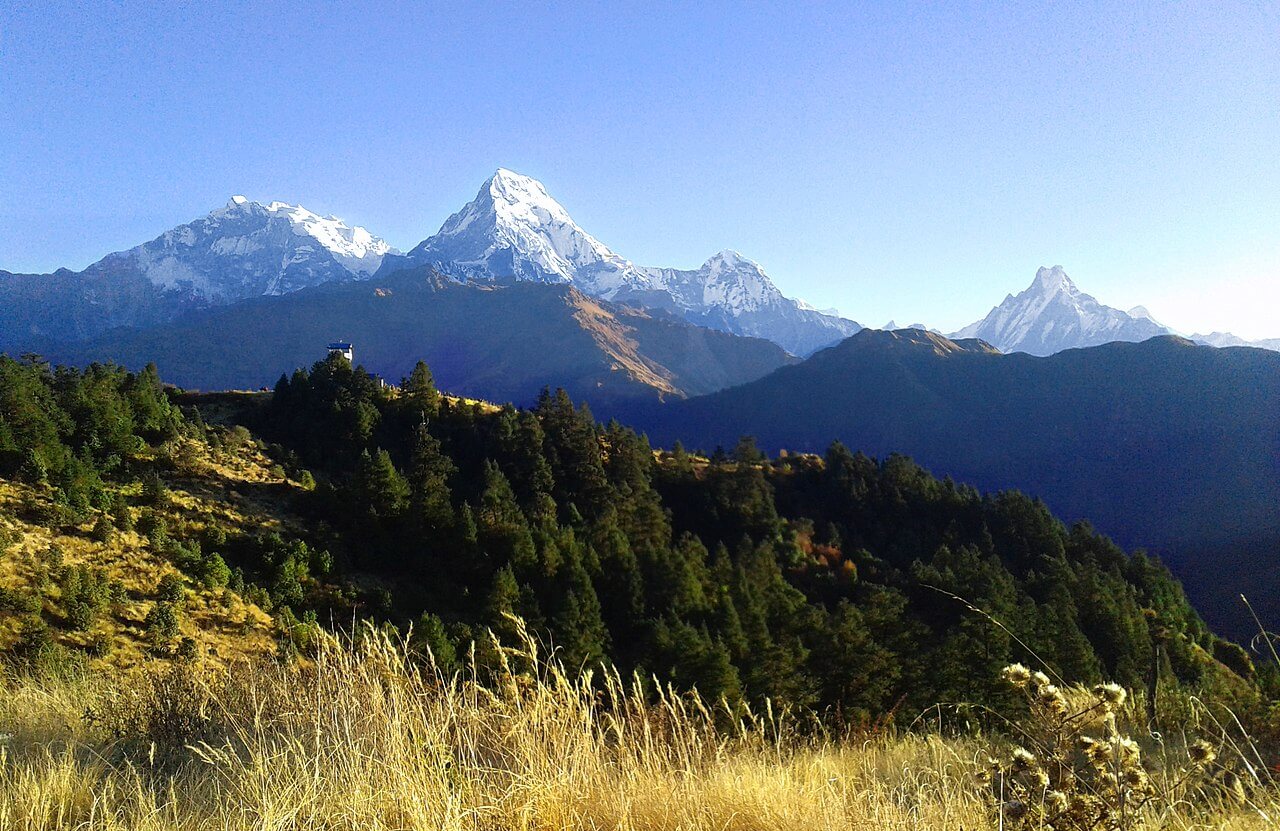
Poon Hill Trek is the most comfortable trek in the entire Annapurna region. Although this trek does not need any climbing or technical skills, the trek is not so simple like walking in a park. The first three days of the trek is steep and strenuous.
The entire trek covers approximately 40 to 44 kilometers depending on the route you choose. On average, you’ll have to walk for about 6 to 7 hours per day for a week. At the elevation of 3,210 meters, Poon Hill marks the highest elevation point of the trek. Although the risk of altitude sickness is slightly less, it is crucial to maintain fitness to protect from the AMS.
It is also vital to prepare well for the unforeseeable weather conditions. The weather in the mountains is always unpredictable and likely to change quickly. Therefore, pack all the essential gears for wet and cold weather.
Since you’ll be walking for long hours every day, invest in high-quality hiking boots. Although the experienced trekkers consider Poon Hill as an easy trek, it requires a certain level of physical fitness to complete the trek.
However, Poon Hill is comfortably doable, even for first-time trekkers. Most of the people consider it as the ideal destination for novice trekkers who wants to experience the Himalayas.
Poon Hill Trek Permit
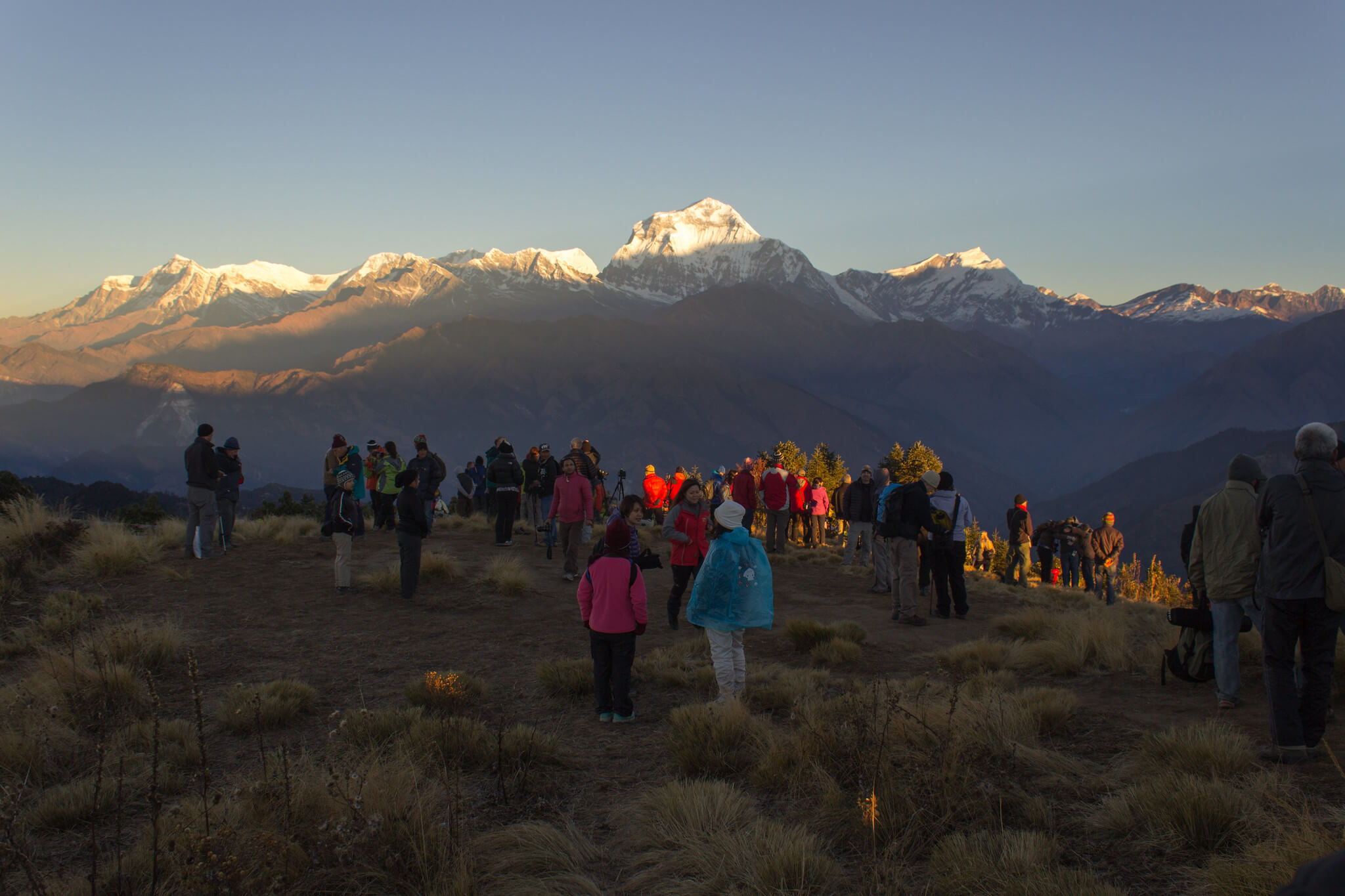
Like other treks in the Annapurna Sanctuary, Poon Hill Trek also requires two different permits — TIMS Card (Trekking Information Management System) and the ACAP permit (Annapurna Conservation Area Project). You do not require any restricted area permits to enter the area.
If you book your trek in an authorized travel company, they’ll take care of all the hassles of the permit for you. However, if you choose to trek independently, you can acquire TIMS Card from Nepal Tourism Board or Trekkers Agencies’ Association of Nepal (TAAN) Secretariat in Kathmandu. There are three types of TIMS Card; green for individual travellers, blue for organized group trekkers, and a pink one for SAARC nationals.
For ACAP Permit, you have to visit the Nepal Tourism Board in Kathmandu or Tourist Office in Fewa Damside, Pokhara.
For both TIMS Card and ACAP permits, you’ll need to have your passport, insurance details, passport size photos, and contact details of a person in Nepal.
To receive the TIMS Card:
- First, fill-up the form at the counter of the Tourist Information Center in Kathmandu or Pokhara.
- Submit your passport size photograph with the form. If you do not have printed photos, you can take a picture in the office without paying any charge.
- Submit the filled out form along with NPR.2000/US$ 18 each to the information center counter. Remember they only accept Nepalese Rupees, so make sure to exchange your dollars to NPR.
- Finally, get your TIMS Card.
To receive the ACAP Permit:
- Upon receiving your TIMS Card, get another permit form from the next room.
- Fill the necessary details.
- Submit the filled form with your passport, photos, and NPR. 3000/US$27 per person (payable in Nepalese Rupees only).
- Get your ACAP Permit.
Here’s the price of the permits required for Poon Hill Trek:
| Required Permits | For International Countries | For SAARC Countries |
|---|---|---|
| TIMS Card | For Individual: | For Individual: |
| NPR.2000/ US$ 18 | NPR.300/ US$ 2 | |
| For Group: | For Group: | |
| NPR.1000/US$ 9 | NPR.600/US$ 4 | |
| ACAP (Annapurna Conservation Area Project) | NPR.3000/ US$ 27 | NPR.1000/ US$ 9 |
Insurance for the Trek
Although Poon Hill Trek is a short and easy trek compared to Everest or Annapurna Base Camp, it is essential to have travel insurance while trekking in this area. As it seems to be not necessary, but we highly recommend you to have proper travel insurance for this trek.
You may come across unpredictable situations — accidents and altitude sickness are quite common while trekking in the high Himalayas. You do not need to include helicopter evacuation in your policy. But, make sure to get an insurance that comprises all the medical charges, natural disasters, trip cancellation, and theft. Though there are very few decent travel insurance companies, we highly suggest you get it done from the World Nomads.
Guided VS Independent Trek
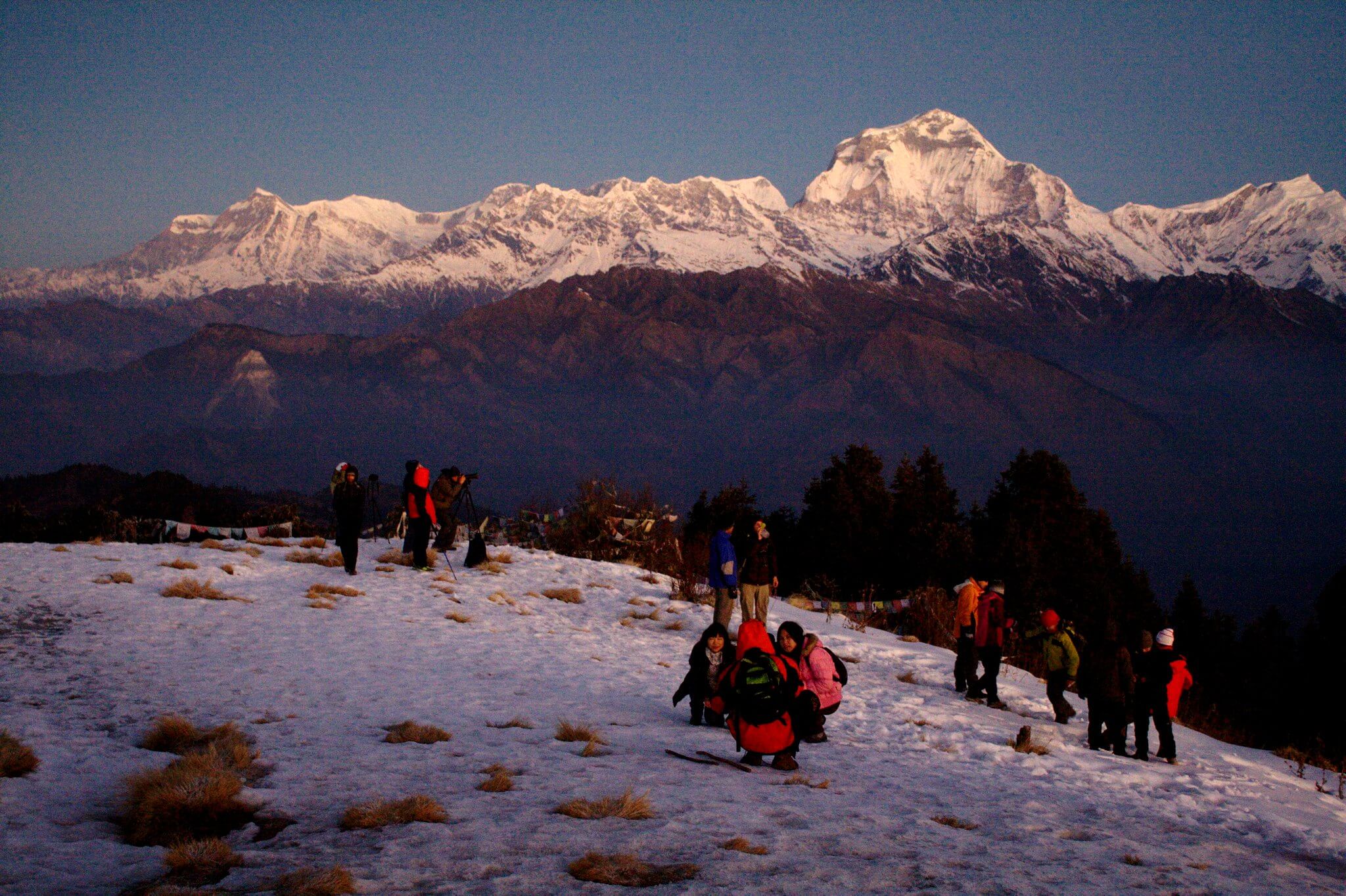
Independent Trek
You can trek both independently or with a guide as per your preference. If you choose to travel on your own, you’ll have to take care of all the hassles such as arranging transportation, accommodations, and carrying your backpacks. However, you’ll have the luxury of changing the plans and itinerary as per your wish.
You’ll meet plenty of locals and tourists throughout the trail and they’ll be happy to cooperate with you about the course. The chance of you getting lost in this route is minimal as there is only one path to Poon Hill.
Pros:
- Relatively cheaper than guided trek.
- It is more adventurous as you’ll be responsible for all the logistics and planning.
- You’ll have the flexibility to make adjustments to your plans as per your wish.
Cons:
- If you get into any trouble, you will not have anyone to accompany you.
- Planning all the logistics might be hectic.
Guided Trek
If you choose to travel with a guide and porter, they’ll help you arrange the permits, transportation, accommodations, and luggage. They’ll guide you throughout the trail and assist you in every situation.
The guide will plan the itinerary and all the arrangements for your trip, which means you won’t have the flexibility to change as per your wish.
Pros:
- No need to worry about finding accommodation, planning the route, and carrying the extra weight.
- With a professional guide, you can learn about places, cultures, and food.
Cons:
- Hiring a guide is spending more.
- It is slightly less adventurous.
Accommodation and Food
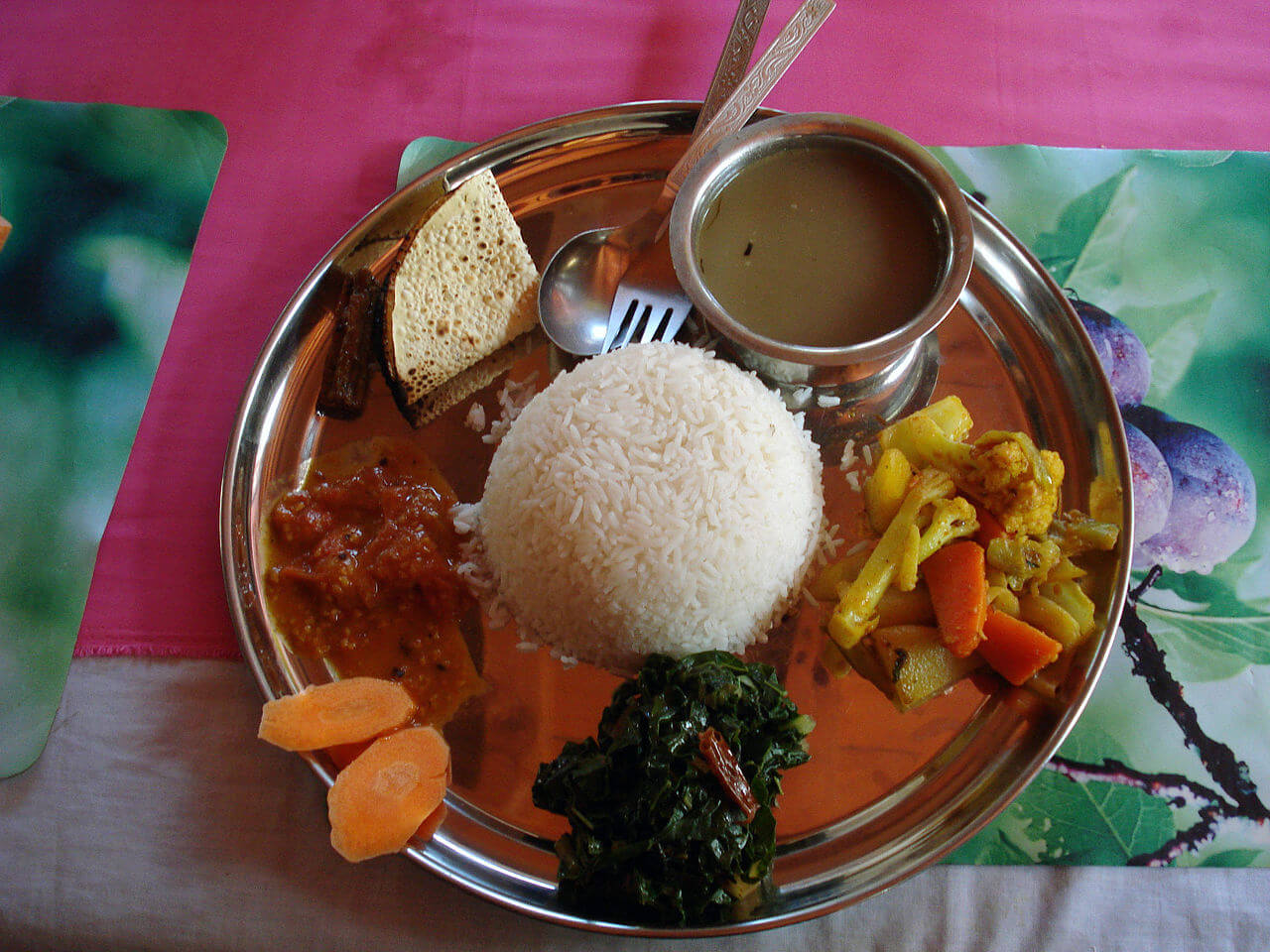
Plenty of hotels and comfortable teahouses are available throughout the trail to Poon Hill. Most of the teahouses are cozy, providing rooms, food, and basic amenities including wifi, hot shower, and charging facilities.
In Pokhara, there are many luxurious hotels to cater to services as per your needs and budget. But, once you start trekking, teahouses facilitate essential services of two single beds in a room, a thin mattress, a pair of bed sheets, and a cushion. The toilets are mostly on a sharing basis without running water. If you want to use additional facilities like the hot shower, wifi, and charging facilities, they may charge you extra bucks for it.
Teahouses also provide meals on their menu. Dal Bhat (Rice and Lentil) is the most popular food in the mountains. Most of the trekkers prefer Dal Bhat to other foods as the portion is quite sufficient to fill the hunger. They also serve a few western menu meals, but the taste may not be as good as a fancy restaurant.
Poon Hill Trek Cost
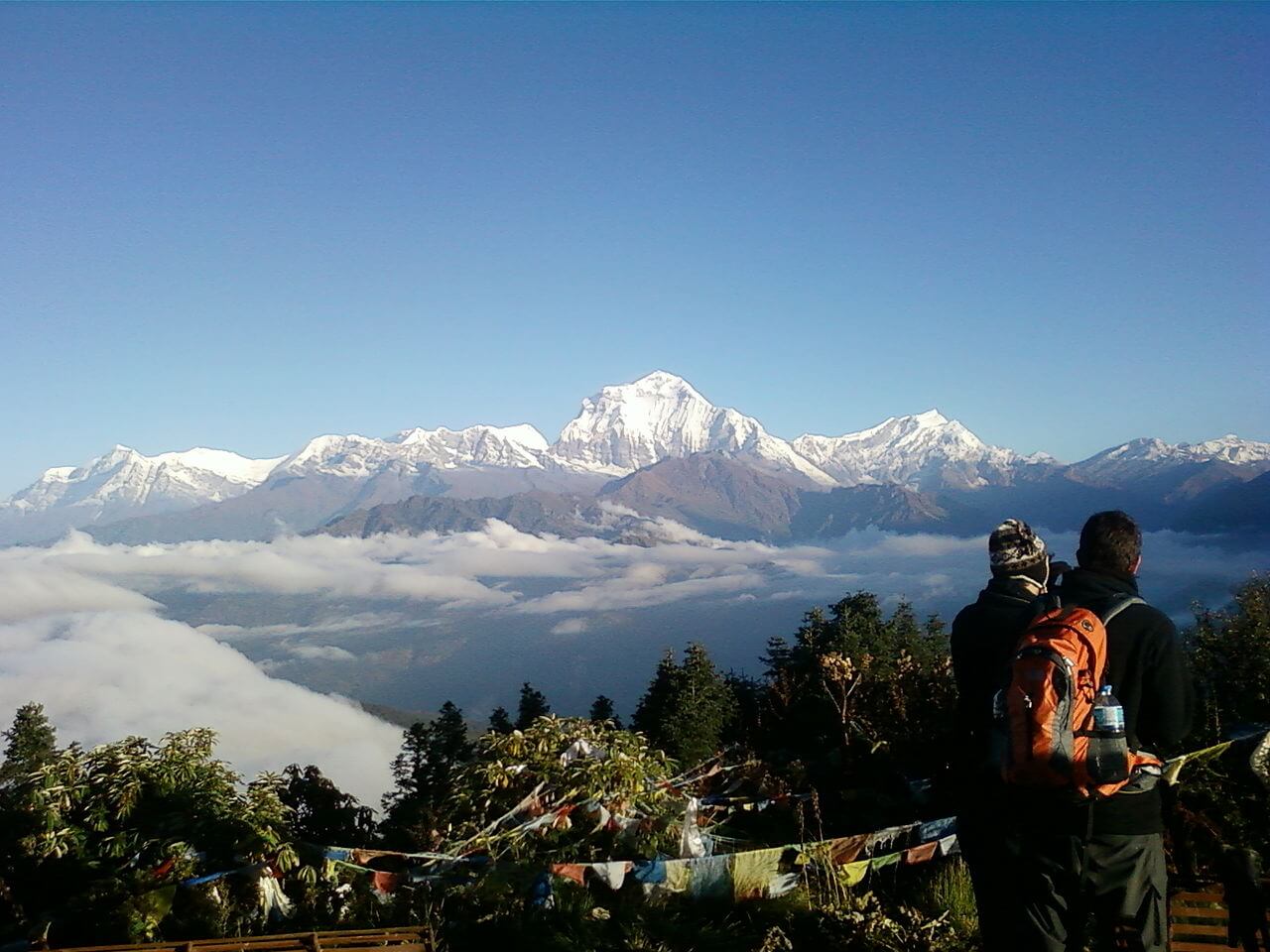
The total cost of the trek depends on different factors such as the total number of days, transportation, route option, and trekking season. As Poon Hill Trek is a short trek, the value of the entire trek is relatively cheaper than other commercial treks in Nepal. On average, a 5-day trip to Poon Hill prices about US$ 200-400, including accommodation, meals, and transportation.
Accommodation in Poon Hill Trek is comparatively cheap, ranging from US$ 2 to 3 on a sharing basis. However, the price of the rooms might go slightly higher during the peak season than at other times of the year. If you’re trekking independently, make sure to negotiate with the initial price as some of the teahouses may have space for discounts on the room charge.
Meals on the trail costs between US$ 4 to 6 as per the varieties. Meat items are more expensive than ordinary dishes. However, we highly recommend you not to have meat items along the trail.
Transportation is cheap and easy to get. If you choose to travel by local bus, the ride from Pokhara to Nayapul costs US$ 2 per person and ride from Ghandruk to Pokhara costs you US$ 4 to 5. The vans are two or three times dearer than the local bus.
The price of the TIMS Card is US$ 18 for an individual trekker and US$ 9 for travellers in a group. Likewise, the cost of the ACAP Permit is US$ 20 per head.
You need to pay extra US$ 1 to 2 for access to a WiFi connection. Similarly, it costs some US$ 1 to charge phone and camera batteries.
If you are planning to hire a licensed guide, you have to pay an additional US$ 20 to 25 per day. Hiring a porter will cost you US$16 to 20. If you want to hire a porter cum guide, they’ll charge you about US$ 18 to 20 per day.
| Services | Cost |
|---|---|
| TIMS Card | For Individual: US$18 |
| For Group: US$9 | |
| ACAP | US 27 |
| Teahouses | US$2-4 |
| Meals | US$4-6 |
| Local Bus | US$2-5 |
| Jeep | US$9-10 |
| Trekking Guide | US$20-25 |
| Porter | US$16-20 |
| Porter Cum Guide | US$18-22 |
Packing List for Poon Hill
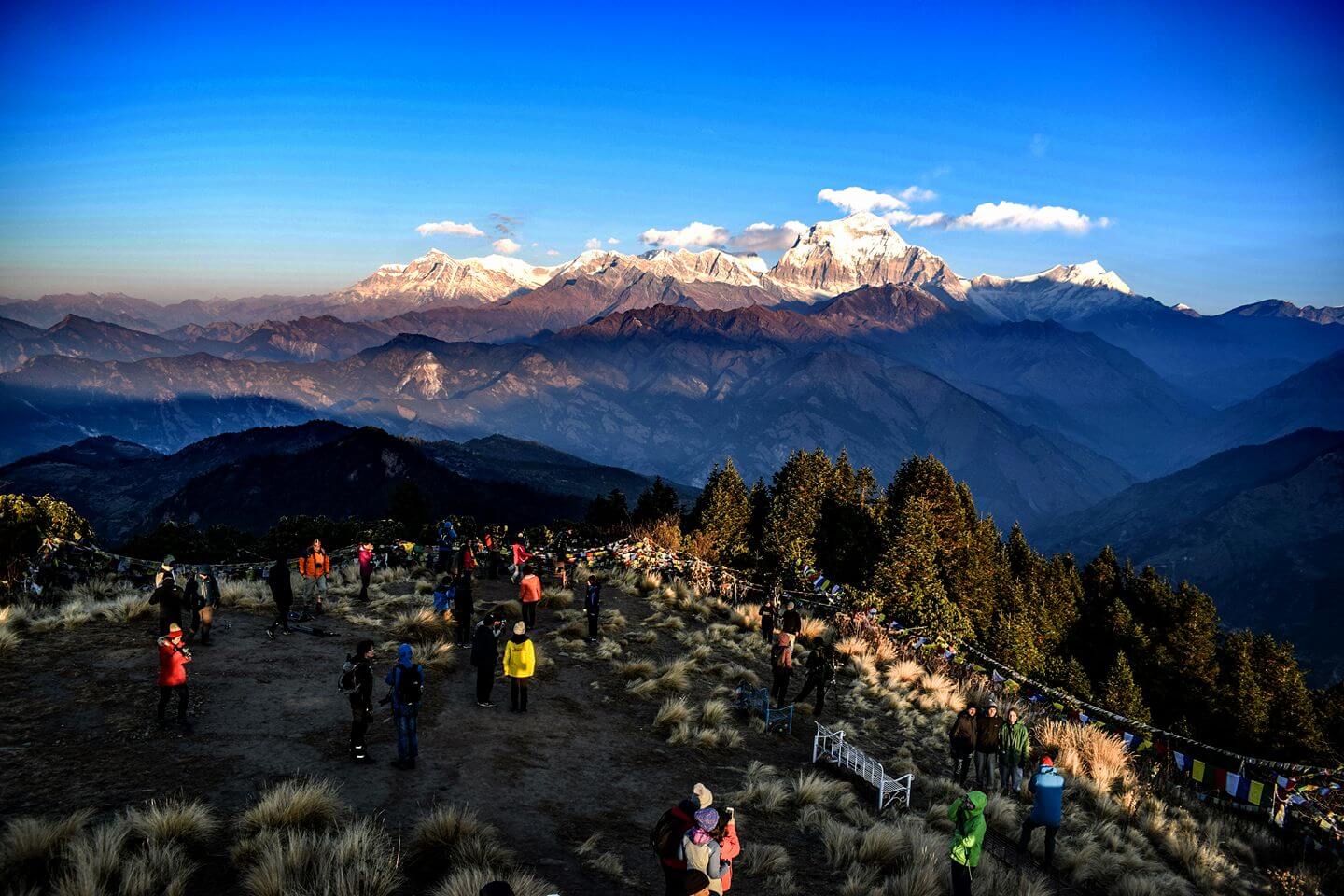
Bags:
- Duffel Bags
- Daypack
Clothing:
- Trekking Shirt
- Trekking Trousers
- Base Layer
- Down Jacket
- Waterproof Shell Jacket
- Breathable Underwear
Footwears:
- Hiking Boots
- Trainers/Sandals
- Hiking Socks
Head Wears:
- Sun Protection Hat
- Beanie
Important Accessories:
- Sleeping Bag
- Trekking Poles
- Water Bottle
- Basic Medical Kits
- UV Protection Sunglasses
- Headlamp
- Water Purification Tablets
- Hand Sanitizers
- Sunscreen/Lip Balm
- Toiletries
Network Information
Network coverage on the trail is pretty decent. Both NTC and Ncell services work fine throughout the trek but weak at Poon Hill. The network connection may not always be available at the vantage point of Poon Hill.
When it comes to mobile internet service, you can expect 3G data coverage in most parts of the trail. Most teahouses provide WiFi services with additional charges. WiFi is the most preferred way to stay connected with your friends and family. But the connection can get slower when the high number of users congest network traffic.
Useful Tips
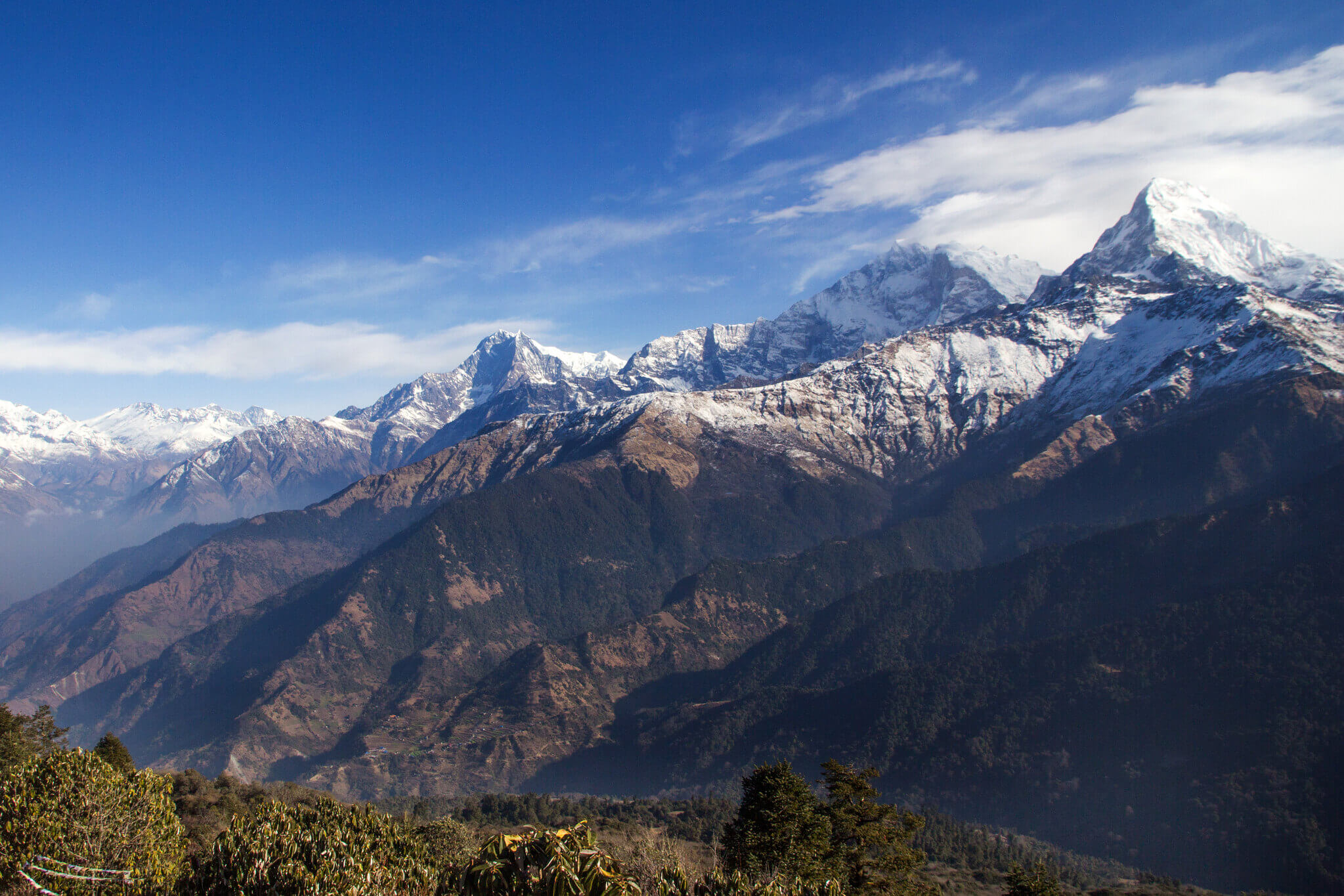
- Carry enough cash. There are no ATMs on the trail.
- Do not forget to carry a waterproof jacket.
- Make sure to carry your water bottle as you can’t buy bottled water on the trail.
- It is handy to bring a portable charger on the trek as charging facilities may not be reliable in the teahouses.
- Although Poon Hill Trek is an easy trek, it is something more. You’ll have to climb strenuous uphills while trekking to Poon Hill. Make sure to stay physically fit and engage in cardio-oriented exercise before the trek.
- Do not forget to carry a decent camera. You might capture the breathtaking sceneries along the trail.
Accommodation in Pokhara
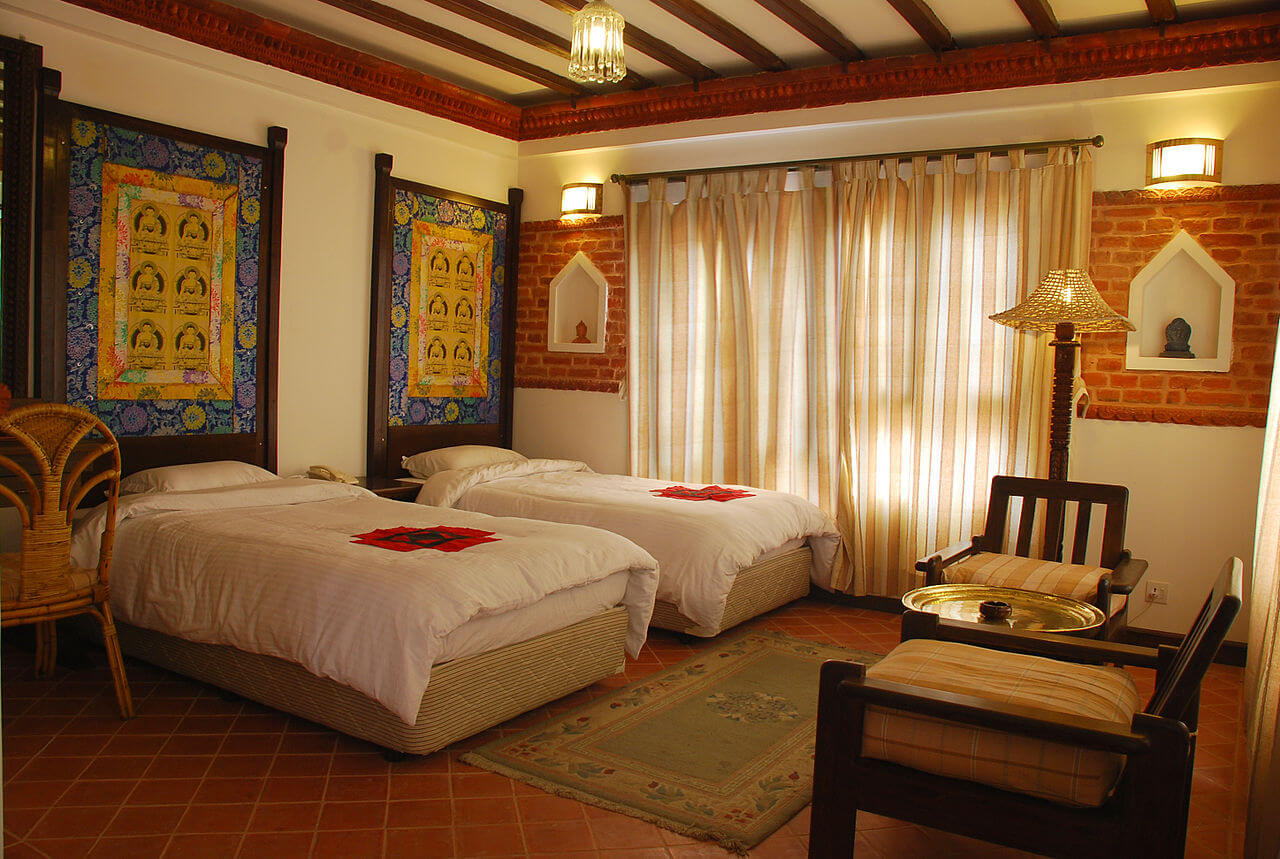
| Budget Hotels | Mid-Range Hotels | Luxury Hotels |
|---|---|---|
| Hotel K2 Pokhara | Kumari Star Inn | Fish Tail Lodge |
| OYO 224 Danfe Hotel Pvt Ltd | Hotel Tulsi | Temple Tree Resort & Spa |
| Hotel Fishtail Inn | Hotel City Park | Hotel Barahi |
| Harvest Moon Guest House | Pokhara Boutique Hotel | Shangri-La Village Pokhara |
| Hotel Fewa Holiday Inn | Hotel Lake Shore | The Pavilions Himalayas |
Recommended Travel Agencies
Recommended Books and Guidebooks
- Annapurna: A Trekker’s Guide
- Lonely Planet – Trekking in the Nepal Himalaya
- The Rough Guide to Nepal
- The Climb
- Into Thin Air
- High Adventure
FAQs About Poon Hill Trek
1. How fit do I need to go trekking in Poon Hill?
Poon Hill Trek is a short and easy one in the Annapurna region. Even novice trekkers with decent physical fitness can do this trek. If you can walk approximately 5 to 6 hours each day, you can trek easily.
2. Can I do Poon Hill Trek independently?
Yes, it is possible to trek to Poon Hill independently. Poon Hill Trek without a guide is a far cheaper and more flexible way to travel. However, it may be slightly difficult to trek on your own as you have to handle all the issues of the trip.
3. Is drinking water safe on the trek?
No, water from local sources and tap is not safe to drink. Additionally, bottled water is also not available to buy in Poon Hill Trek. Make sure to carry a water bottle with you and refill the water in the teahouses.
4. What is the standard of the accommodation on the trek?
The teahouses in Poon Hill Trek has standard accommodation services. Most of the lodges provide rooms with twin beds, attached bathrooms with running hot water. However, these teahouses may charge you extra bucks for wifi and charging facilities.
5. Is there any possibility of Acute Mountain Sickness?
Generally, altitude sickness occurs after you exceed the elevation of 3,000m above sea level. Poon Hill lies at an altitude of 3,210m. As you will spend a short period at the threat zone, the possibility is very minimal.
However, it is always better to stay precautious while trekking at high altitudes.
6. Do I need travel insurance for Poon Hill Trek?
Although Poon Hill Trek is relatively short and comfortable, it is advisable to have travel insurance for the trek. You only need basic insurance that covers at least medical costs, theft, accidents, and natural disasters.
Conclusion
Poon Hill Trek is a short and comfortable adventure through rhododendron forests to the vantage point that offers marvellous Himalayan panorama. If you hike to Poon Hill early in the morning, the sunrise over the mountains is a majestic sight to relish.
This trek offers you not only the mountain views but also the cultural experience of Gurung inhabitants.